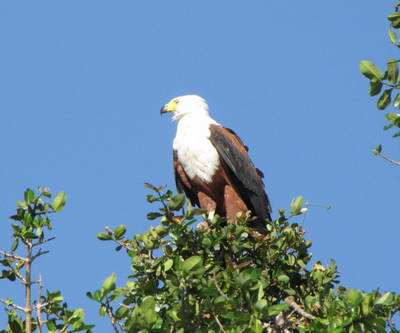
Fish Eagle |
- sharp bends
- crocodiles (many, of all sizes)
- one hippo
- two houseboats
- one group fishing from a boat
Without the wind the heat was oppressive. It wasn't long before a large bull elephant was spotted, but after that, no more animals - plenty of poo, but no perpetrators! Still, the trees and plants were interesting, and we survived the punt-ride back to Pepere, and a picnic lunch of cheese and ham sandwiches (no alternative for the vegetarians!) and apples. Three elephants thought about gatecrashing the party, but decided to trundle off - we had finished the sandwiches in any case.
After that we had the long, speedy and curvey ride back to the Swamp Stop for tea & biscuits before heading for a cool shower.
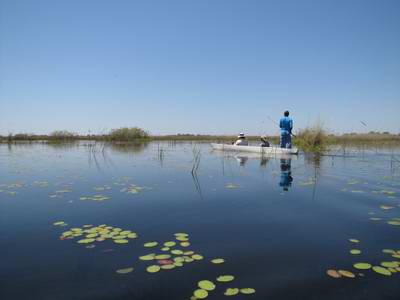
Crossing open water
in the mokoro
|
Wednesday 12 October
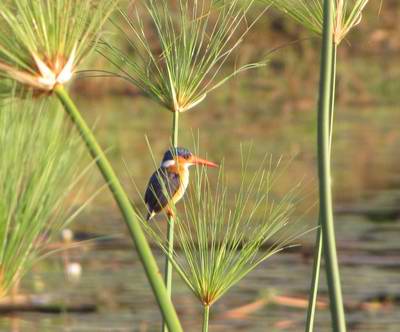 |
Malachite Kingfisher
at the Swamp Stop
|
Time to move on again, and leave the land of the 'Pula' to the land of the Namibian Dollar. Our first stop was therefore in the last town before the border, Shakawe, so that we could spend or change the last of our pula. Actually no-one could change any money because of the length of the queue at the bank, so most of us finished off our money to buy balls, pens, pencils and paper to donate to the school we were due to visit the next day. Suitably laden, and re-stocked with water, we continued our journey - two more stamps in the passport and we were in Namibia.
The problem with straight roads, heat and unchanging scenery, is falling asleep - and I think we all had a few Zs (apart from the drivers!) en route. The other battle we had was keeping the windows open at the right height - this entailed having a collection of sticks of varying lengths which would hold the window at varying heights. Sustainable technology!
Two hundred or so kilometres later, having had a picnic lunch at a lay-by under a large tree, we arrived in Rundu - where we were surprised to find a four storey building under construction. In a town of shacks it looked out of place. It turned out to be a new health centre.
It was very hot, and for once standing for a long time in the bank queue to change money was an air-conditioned pleasure. After an hour in this sandy town we got back in the vehicles for the 20 km dirt road drive to n'Kwazi Lodge. This lodge gets its own half-page write-up in the Rough Guide, because of the involvement of the owners with the local community. Various activities were on offer, the proceeds of which go to projects in the villages. The cabins were solidly built of timber and had dark but cool interiors. It is obviously popular as two other overland tours were there that night.
Before the superb buffet dinner we had a singing and dancing display (Activity 1: 50 Namibian $) - great harmony singing and hip-wiggling dances in bamboo curtain skirts (men & women).
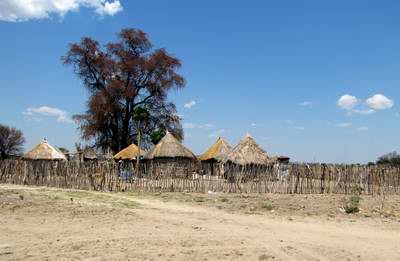 |
Namibian village by the main road |
Thursday 13 October
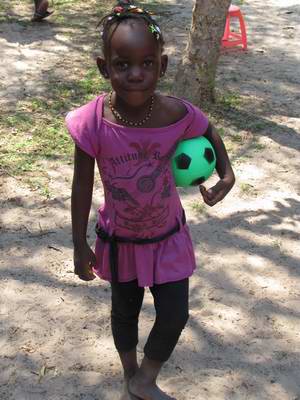 |
Child in village pre-school |
Activity 2 (100 Namibian $) started at 9 o'clock - a visit to the local pre-primary school some 2 km across dry sandy open savannah from the lodge. The children, all under 6 or so years old, sang us a welcome song (which we responded to with 'Old McDonald had a Farm'), and then we gave them some balls (tennis, football and every size in between) and apples. After the chaos subsided we looked around the classrooms and spoke to the teacher - on her own at the moment with 38 children, as the other teachers were away training! It turned out she was one of the dancers from the previous evening too.
After the school visit we were taken by our guide, Moses, on a sinuous route back to the lodge via a number of family compounds (Activity 3 - village visit 50 Namibian $) where we were able to look around and talk to the inhabitants - almost entirely women as most men had left to find work elsewhere, and had not returned.....
The families had very little, the ground was dry sand and water had to be fetched from the river. Moses himself had made a garden in his village nearby, with the help of a water pump and much compost, but he implied that few people had followed his example.
Activity 4 (50 Namibian $) took place after lunch and a long siesta, and was a sunset cruise on a 'catamaran' constructed from two kayaks joined by a flat board on which 10 dining chairs were arranged. On this fine vessels we chugged slowly up the river, seeing groups of people washing themselves, their children and their clothes in the river. The river was very shallow in places, ripples in the sand on the river bottom could be seen through the brown water. After half an hour Hans, the captain, pulled over to the Angolan bank where a group of dripping teenage girls (they had just forded the river!) sang us a welcome song, and we took photos of our illegal entry to Angola.
After giving the girls a lift part-way across the river, we continued up river for a while before drifting back downstream as the sun dropped slowly into the water upstream.The final excitement was a trio of otters heading down river, and a single croc coming upstream - hopefully they didn't meet!
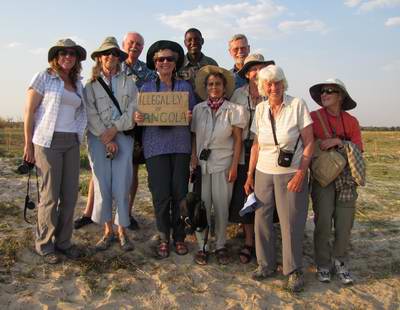 |
Incursion into Angola during sunset cruise on the Kavango River |
Friday 14 October
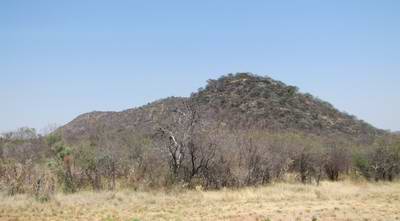 |
The first hill seen so far in our trip! |
We had a very early start in order to get to the Etosha National Park in time for a game drive before the gates on our accommodation closed at 18.30. In the end we made it with 25 minutes to spare.
En route one of the main difficulties was staying awake - the road from Rundu to Grootfontein, 250 km, was almost dead straight, with little variation in the scrub scenery either side. Occasional villages had pottery, oranges or wood for sale, but that was it! Approaching Grootfontein a hill or two appeared - a bit of a shock after ten days of flatness (OK we did get a distant view of the Tsodilo hills in Botswana). Rocks also appeared, lumpy bits of limestone.
We reached the entrance to Etosha National Park just after another tasty picnic lunch beneath a shady tree. All hills had disappeared again, and the flat plain, and flooded eastern end of the Etosha Pan stretched away in the distance.
We saw the evidence of a disastrous fire the occurred last month, killing many animals including three lions, several rhinos, elephants and many antelope. The animal trails stood out light against the blackened ground. In places all trees had burnt, but mostly the trees seemed to have been spared and some were still green.
We arrived just before sunset, and got directions to the water-hole adjacent to the camp just in time to see the blood-red sun set behind a drinking giraffe and elephant. Later that night some of us returned to the water-hole and were rewarded with a family of nine elephants arriving, displacing a black rhino, but not affecting a solitary giraffe and the occasional slinking jackal. Incredible sight!
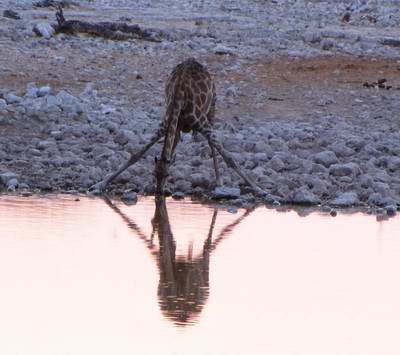 |
Giraffe drinking at water hole at sunset |
Saturday 15 October
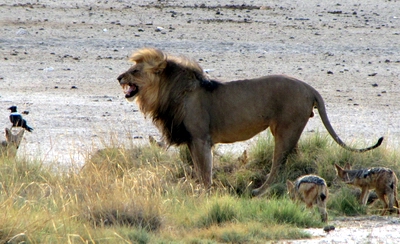 |
Lion male at the kill, with jackals |
Up early in order to catch the rising sun, and do a game drive before the heat drove animals into the shade, and cover. Apart from some zebra and korhaans our first serious sighting was a pride of lions at the Okondeka water-hole. They had obviously finished feeding on a recent kill, and a couple of females and four cubs were heading into the shade of a bush, whilst two males and one female remained closer to the kill, which was now overrun by jackals. We spent a long time watching the action - which included one male mating with the female, twice.
After this excitement the next couple of hours was somewhat quieter, but with plenty of other interesting sights - the best being a small group of ground squirrels huddled together, with the two males showing off their large testicles - the largest in proportion to body size of any mammals.
Once again the highlight of a day full of highlights came after dinner at the water-hole. There were at one point nine black rhinos at the pool, one young one being suckled - an awkward process with the horn on its forehead! It seemed to involve lying sideways at an angle under the rear of the mother. As this was going on, and two giraffe were cautiously approaching the pool, two lionesses appeared with three cubs and quietly drank at the far edge of the pool. Just after 11 pm, when the pool was deserted, elephants started arriving. I headed off to bed when I lost count at around 30 elephants of all sizes!
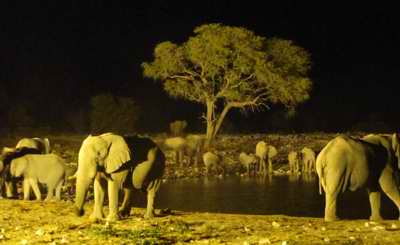 |
Elephants at the water-hole at night |
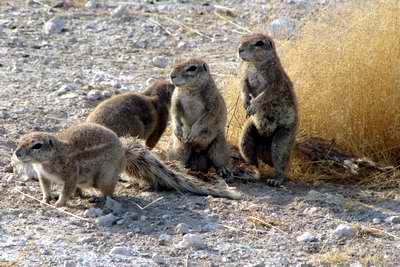 |
Ground Squirrels |